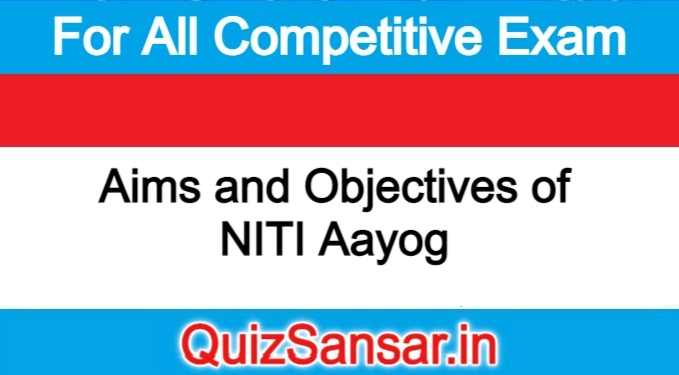
Aims and Objectives of NITI Aayog
The following are some of the important aims and objectives of
NITI Aayog:
1. NITI Aayog sets its aims to provide a critical directional and strategic input into the development process of the country.
2. NITI Aayog aims to serve as a “think tank” of the government both at central and state levels with relevant strategic and technical advice on key policy matters including economic issues of national and international importance.
3. NITI Aayog now seeks to replace the centre-to-state one way flow of policy framed by the Planning Commission by an amicable settled policy framed by a genuine and continuing partnership of states.
4. The NITI Aayog will also seek to put an end to slow and tardy implementation of policy by fostering better Inter-Ministry co ordination and better centre-state co-ordination. It will help evolve a shared vision of national development priorities, and foster co-operative federalism, in order to focus on the view that strong states make a strong nation.
5. The NITI Aayog has set it objectives to develop mechanisms to formulate credible plans to the village level and aggregate these progressively at higher levels of government. This Aayog will ensure special attention to the sections of society that may be at risk of not benefitting adequately from economic progress.
6. The NITI Aayog, will create a knowledge, innovation and entrepreneurial support system through a collaborative community of national and international experts, practitioners and partners. The Aayog will offer a platform for resolution of inter-sectoral and inter departmental issues in order to accelerate the implementation of the development agenda.
7. The NITI Aayog will monitor and evaluate the implementation of programmes, and focus on technology upgradation and capacity building.
Undertaking the above activities, the NITI Aayog will aim to
accomplish the following objectives and opportunities: (i) An effective administration paradigm in which the Government is an “enabler” rather than a “provider of first and last resort”.
(ii) Attaining progress from “food security” to focus on a mix of agricultural production as well as attain actual returns that farmers get from their produce.
(iii) To ensure that India is an active player in the debates and deliberations on the global commons.
(iv) To ensure that the economically vibrant middle-class remains actively engaged, and its potential is fully utilized.
(v) Leverage India’s pool of entrepreneurial, scientific and intellectual human capital.
(vi) Incorporate the geo-economic and geo-political strength of the non-resident Indian Community.
(vii) Use urbanization as an opportunity to create a wholesome and secure habitat through the use of modern technology.
(viii) Use technology to reduce opacity and potential for misadventures in governance.
Moreover, the NITI Aayog aims to enable India to face complex challenges in a better way through the following measures:
(i) Leveraging of India’s demographic dividend and realization of the potential of youth, men and women through imparting education, skill development, elimination of gender bias and also by providing employment.
(ii) Elimination of poverty, and the enhance the chance for every Indian to live a life of dignity and self-respect.
(iii) Redressal of inequalities based on gender bias, caste and economic disparities.
(iv) To integrate villages institutionally into the development process of the country.
(v) To provide policy support to more than 50 million small business which are considered as a major source of employment generation.
(vi) To safeguard our environmental and ecological assets.
Thus the NITI Aayog will try to frame a proper development policy for the country and will also seek to put an end to slow and tardy implementation of policy, by fostering better inter-ministry coordination and improve Centre-State coordination. It will also evolve a shared vision of national development priorities, and foster co-operative federalism, recognizing the motto that strong states make a strong nations.
Critics of this new set up criticised it and some termed it as an old wine in a new bottle. However, some critics have also argued positively in its favour.
Arun Maira, former Planning Commission member, observed that “The idea to create an institution where states’ leaders will be part and parcel of the collective thinking with the Centre and the other stakeholders in formulating a vision for the development of the country is right one as compared with previous structure, where a handful of people formulated the vision and then presented it to the National Development Council (NDC). This was not entirely absorbed and adopted by the latter”.
However, it is too early to comment on the efficacy of the new institution related to planned development, something possible when it shifts gears and moves into operation seriously. However, the present move to decentralize planning and allowing inputs from states to guide it, appears to be a positive and effective steps.
Another positive side of these institutions is to establish a dynamic institutional mechanism where eminent individuals outside the government system could contribute towards policy making. Moreover, one of the major tasks of the NITI Aayog is to actively monitor and evaluate implementation of programmes and initiatives which is something new under the present setup.






